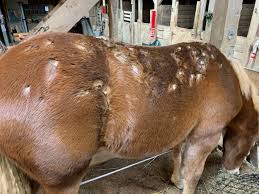Rain rot, also known as rain scald or dermatophilosis, is a bacterial skin infection that plagues horses, particularly during wet and humid weather. While not life-threatening, it can cause discomfort, affect a horse’s appearance, and even lead to secondary infections if left untreated. This comprehensive guide delves into the intricacies of rain rot in horses equipping you with the knowledge to effectively prevent, identify, and manage this prevalent condition.
Unveiling the Culprit: The Bacterium Behind Rain Rot
The bacterium responsible for rain rot is called Dermatophilus congolensis. This opportunistic pathogen resides on a horse’s skin in a dormant state under dry conditions. However, when exposed to prolonged moisture, warmth, and unsanitary environments, Dermatophilus congolensis transforms into an active pathogen, breaching the skin’s natural defenses and triggering an infection.
Factors Contributing to Rain Rot Development
Several factors contribute to the development of rain rot in horses. Here are the key culprits:
- Excessive Moisture: Rain, sweat, or damp environments provide the ideal breeding ground for Dermatophilus congolensis. Horses with inadequate shelter during wet weather, those living in humid regions, or excessively sweaty horses due to heavy workloads are particularly susceptible.
- Compromised Skin Barrier: Cuts, scrapes, insect bites, or sunburn can create openings in the skin, allowing bacteria to gain easier entry and establish an infection.
- Poor Hygiene: A dirty coat matted with mud or debris can trap moisture and create a breeding ground for bacteria. Regular grooming and proper hygiene practices are crucial for preventing rain rot.
- Weakened Immune System: Horses experiencing stress, malnutrition, or underlying health conditions may have a compromised immune system, making them more vulnerable to bacterial infections like rain rot.
- Improper Blanketing: Using a poorly ventilated blanket can trap moisture against the horse’s skin, mimicking the effects of constant rain and creating a favorable environment for bacterial growth.
Recognizing the Signs: Rain Rot’s Telltale Symptoms
A keen eye can readily identify rain rot in its early stages. Here are the signs to watch out for:
- Crusting and Scabbing: The initial sign is the formation of crusty scabs along the back, rump, shoulders, or flanks. These scabs may appear raised, yellow, or brown and often mat together with the horse’s hair.
- Hair Loss: As the infection progresses, the scabs detach, revealing patches of hair loss. The affected areas may appear raw, red, and irritated.
- Tenderness: Rain rot can cause discomfort and sensitivity in the affected areas. The horse may flinch or react when touched in these regions.
- Lesions and Pus: In severe cases, the scabs may become thick and infected, oozing pus. This indicates a deeper infection requiring immediate veterinary attention.
Differentiating Rain Rot from Other Skin Conditions
Several other skin conditions can mimic rain rot’s symptoms. Here’s how to differentiate them:
- Ringworm: This fungal infection often appears as circular patches of hair loss with a raised, red border. Unlike rain rot, ringworm is highly contagious.
- Lice and Mites: These parasites can cause intense itching and hair loss. Look for live lice or mites crawling on the horse’s skin and signs of excessive scratching.
- Urticaria (Hives): This allergic reaction causes raised, itchy welts that appear and disappear quickly. Unlike rain rot, hives are not associated with scabbing or hair loss.
If unsure about the cause of your horse’s skin lesions, consulting a veterinarian is crucial for an accurate diagnosis and appropriate treatment plan.
Strategies for Effective Rain Rot Prevention
Prevention is always better than cure. Here are some proactive measures to safeguard your horse from rain rot:
- Provide Adequate Shelter: Ensure your horse has access to a well-ventilated shelter during wet or humid weather. This could be a stable, run-in shed, or a high-quality turnout blanket that allows for breathability.
- Maintain a Clean and Dry Coat: Regularly groom your horse to remove dirt, mud, and debris. During wet seasons, consider blanketing your horse with a breathable blanket after exercise to wick away sweat and prevent moisture buildup.
- Manage Hygiene: Regularly clean your horse’s grooming tools and tack to prevent the spread of bacteria. Wash your hands thoroughly after handling a horse with rain rot.
- Support a Healthy Immune System: Provide your horse with a balanced diet rich in essential nutrients and ensure they have access to fresh, clean water. Regular deworming and parasite control are also crucial for maintaining a robust immune system.
- Address Underlying Issues: If your horse has recurring skin problems, consult your veterinarian to rule out any underlying health conditions that may
Conclusion: Conquering Rain Rot and Keeping Your Horse Healthy
Rain rot, while a prevalent concern, is a manageable condition with proper knowledge and proactive measures. By implementing the preventative strategies outlined above, maintaining a vigilant eye for early signs, and seeking veterinary attention when necessary, you can effectively safeguard your horse’s health and well-being. Remember, early intervention is key to a swift and successful recovery from rain rot.
If your horse develops rain rot, partnering with your veterinarian is crucial for a personalized treatment plan. Treatment typically involves topical medications, antibiotics in severe cases, and diligent wound care to promote healing and prevent secondary infections. With patience, proper care, and a commitment to good hygiene practices, your horse can overcome rain rot and return to its healthy, vibrant self.
By understanding the causes and symptoms of rain rot, implementing preventive measures, and taking prompt action when necessary, you can ensure your horse enjoys a healthy coat and a comfortable existence, rain or shine.




